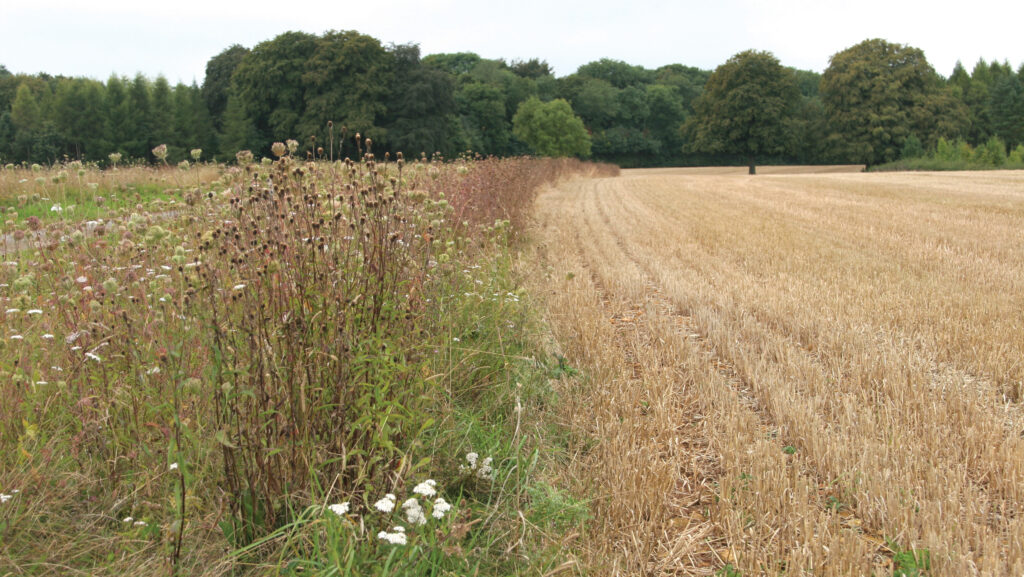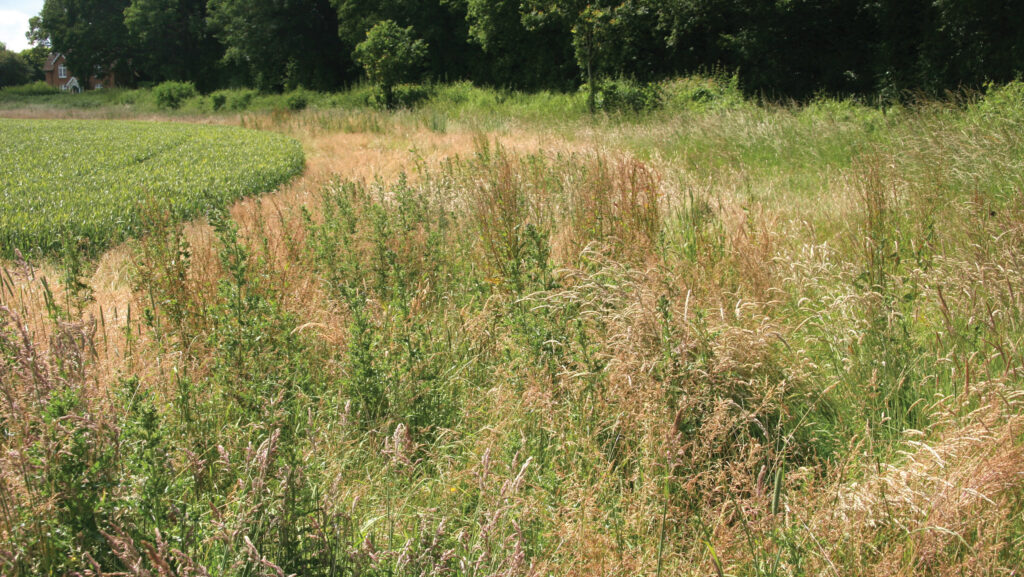How SFI grassy corners and blocks can work most effectively
 © Marek Nowakowski
© Marek Nowakowski Grassy corners and blocks are perhaps potentially one of simplest of all the Sustainable Farming Incentive (SFI) options to implement, but, as ever, to deliver the maximum benefit for the farm and the environment it is worth doing more than the bare minimum required.
CAHL3 or AHL3 (depending on whether it is a 2023 or 2024 agreement) pays £590/ha and cannot be rotated, meaning it must remain in place for the three years of the agreement.
In 2024 agreements, they are part of the limited area actions that must not add up to more the 25% of the farm area in total.
See also: Making the most from pollen and nectar mixes in SFI
The aim is to create a grassy field corner or block with an intact grass sward throughout the year, without tracks, compacted areas or poaching.
Defra’s guidance says that by allowing a tussocky grass structure to develop, it will provide a year-round habitat for a range of wildlife and support an integrated pest management approach if located close to cropped areas.
Farmers have a choice when deciding how to establish grassy field corners and blocks.
Use natural regeneration or sow specific species, says Marek Nowakowski, an environmental stewardship consultant from the Wildlife Farming Company.
“Natural regeneration is cheap, but you are unlikely to get the environmental or agricultural benefits because you’re much less likely to grow grasses that give you the tussocky structure that benefits wildlife and soil,” he stresses.
Tussock grasses grow in clumps, tufts, hummocks or bunches, rather than forming a short, tight sward.
“Regeneration reminds me of ‘set-aside’, and I feel strongly that £590/ha for walking away from land that isn’t doing much for your farm or the environment is too much, when research shows that it seldom delivers much for the wildlife aims you’re expected to meet.
“I’d pay £300/ha maximum for regeneration, but the full amount where sown.”
Sowing species
In contrast, sowing the right range of species, most of which are deep-rooting and will form tussocky structures, allows a range of benefits occur, he says.
This includes improving soil structure, as well as providing a variety of habitats at different times of year.
Those habitats are crucial for wildlife, including beetles, web-building spiders and small mammals.
“Some bumblebees that nest in old small mammal nests also benefit.
“And if you have small mammals, you also have kestrels, barn owls, tawny owls, while the strips also are good for ground-nesting birds, like pheasants and grey partridges.”
Tall grasses, such as cocksfoot, tall fescue, meadow fescue and timothy grass, are key to obtaining the tussocky structure.
The mix should also contain species such as creeping red fescues and crested dog’s tail to provide some lower vegetative cover.
This will also protect against annual grasses such as blackgrass, Marek advises.
“The worst thing is to have tussock-forming grasses surrounded by bare ground as blackgrass will have a field day.
“If you have canopy closure and ground cover, that will help with blackgrass control.”
Cocksfoot is the classic tussock-forming grass, Marek notes: “There are a lot of mixes available commercially, but I’d look for one that had at least 20% cocksfoot to provide the backbone.
“A mix I’ve used to good effect over the years is 30% cocksfoot, 25% meadow fescue, 18% red fescue, 15% tall fescue, 10% timothy and 2% tufted hair-grass.”
Such a mix normally costs around £120-£160/ha.
Tufted hairgrass – Deschampsia cespitosa – is good, in particular for wetter areas, Marek says.
“It is nearly an aquatic grass, very hard wearing, but its tussock structures are warm and dry for overwintering insects.”

© Marek Nowakowski
Location
The perfect option for squaring up the farmed area is by taking out awkward corners, areas around telegraph poles, or odd shaped field boundaries.
This spreads AHL3 refuge areas around the farm and will help maximise the benefits.
“The less mobile insects, such as carabid beetles, won’t move great distances, maybe up to 80m, so they’re not going to move miles if you just have one block on the farm.
“Little and often spread around the farm is much better.”
They work well in conjunction with both AHL1 pollen and nectar flower mixes and IPM2 flower margins and corners.
They do this by providing easy refuge for insects to move from pollen and nectar mixes that are cut at the end of the season.
It can also provide protection for those more sensitive areas, Marek adds.
He’s encouraged growers to create a green living fence between cropped areas and the pollen and nectar, or other similar sensitive habitats with an AHL3 strip.
“The only caveat is to make them wide enough to withstand the pressures of farming and any overenthusiastic cultivation or spray drift.
“I’ve seen 2m margins and within three years, they’ve been eroded to nothing.”
Unlike flower mixes, grassy strips can also be located on the north side of hedges without diminishing effectiveness too much, he adds.
“As it is colder, the north side is where many insects will hibernate and won’t be woken up by one sunny day in February.”
But don’t locate all of the strips on the north side, as the south side is where many of the bees and insects will need the sun for breeding.
“The north side produces one value while the south another, and east/west is in between.”
Another tip is to be careful locating the strips next to blackthorn hedges. “It’s a very aggressive suckering species that can quickly turn your tussocky grass into a much wider hedge.”
Establishment
As with most of the environmental options, sowing a fine, firm seed-bed is best.
Seed rates of about 20kg/ha in either April or August are generally most reliable, broadcast rather than drilled, Marek says.
“Where blackgrass is the primary enemy, go for spring, as blackgrass is still more likely to germinate more freely in the autumn.
“Ring roll after broadcasting and then mow in the first year as often as necessary.”
Where blackgrass is a threat, don’t rush in with the mower too soon, he says.
“I would make the first cut around mid- to late flowering of the blackgrass, well before any seed has reached viability.
“If you start mowing too soon, you will spend your life mowing and, in the end, select for shorter and shorter blackgrass.”
A key difference between mowing in the first year in tussocky grass and pollen and nectar flower options is try not to cut the grass at the end of the season as with flowers, Marek stresses.
“Otherwise, you remove the tussock structure that gives the insects their refuge, warmth and protection over winter.”
There is a balance required, he admits: “You need to cut as often as needed to stop the spread or seed set of annual weeds.
“If that means going into the first winter with a relatively short sward, so be it. But if there is no need to cut at the end of the first season, don’t cut.”
Year 2
In year two, back away from cutting unless you see a problem that demands it, such as heading blackgrass or injurious weeds.
Once established the strips can be useful in helping to build beneficial insect numbers to fight against crop pests.
“But while they will help reduce pest problems, they won’t completely solve them,” Marek says.
If you’re using them as in-field strips, Marek suggests either connecting them to headlands, but farm through the first few metres, or stop them two to three drill widths from the field edge.
“I would rather you connect and farming through them, even if it sounds counter-productive.
“Doing that you will leave a small percentage of the grass structure, which will help species find the in-field strip,” he concludes.
In the series
Follow the links for guides on how to succeed with a variety of SFI options:

